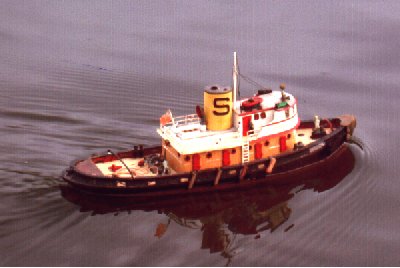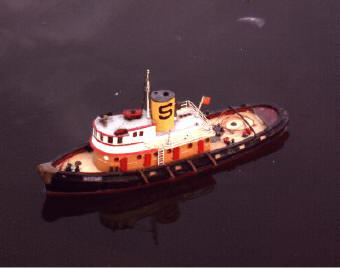Malcolm Frary |
|||
| Tuna Boats | Lotse | ||
 |
Gytha |
|
|
|
Here are a couple of pictures of "Gytha", one taken under way, with a bit of a bone in her mouth, and one just posed, which were taken by Bob Turner, my club chairman, while playing with his new toy. Why "GYTHA"? If you read any of Terry Pratchett's books, you will find that Gytha is a short, tubby, cheerful, capable witch. It just seems to fit. She is a typical harbour tug of US design, from a plastic kit marketed by Lindberg (Lindberg "Classic" series). All of 13" long, she is fitted with 2 channel radio control using standard size parts. As someone once said - "It's a bit snug in there". The running gear is mostly home made, but the original propeller was used, although the blades had to be massively filed thinner to provide forward, rather than sideways, propulsion. Although sold as a display kit, the rudder was provided with a tiller arm with a hole for an operating wire. This was encouraging. The deck was opened and fitted with the highest coaming I could manage, pierced only on its back face to pass the rudder linkage out. I don't believe in burying working parts where they cannot be accessed later. They will need servicing at some stage. The high coaming has proved its worth many times. It has always been a "dry" boat. Just as well really - the only time I ever saw one of these on the box was a Discovery Channel documentary about the US Coast Guard, where the crew of the tug was being rescued just before it sank. Glazing was added to
the ports (Sellotape, stuck on from behind, sticky side outwards, it
hasn't picked up any stray muck in ten years) and bridge windows, and
LED's fitted to be nav lights. The life raft on the bridge roof was
pressed into service as a cover to hide the slide switch for these. The prop shaft is a length of chromed brass tubing (a bit of dead aerial) with plastic tube bearings and a shaft of 1mm brass wire. It is arranged that the inner bearing is above the water line. Some think this a bit olde-worlde, but it works well at keeping the insides dry. The motor was a head drive motor from a dead CD player, and the coupling a short length of cable insulation. The motor is mounted on a balsa pillar, motor, pillar and hull being respectively joined by pads of blue tack. Control is by the innards of a servo. I would probably have used the servo motor, but it is much easier to couple to a longer shaft. The receiver lives under the prop shaft, the steering servo as far forward as possible (even more blue tack) and the four NiMH AA cells are soldered in a sausage string and live under the aft deck. The lighting is worked by a 9v battery which just wedges in nicely between the motor mount and the steering servo, providing a bit of mechanical stiffness and just enough ballast to ensure sailing which is both at waterline and upright. She was previously fitted with Ni-Cad cells, and gave a duration of about 90minutes. I have yet to find out how long the NiMH battery will last. The battery connections are brought out to a socket via a resistor and a bridge rectifier. This makes charging easy, as I don't have to remember what polarity the charger should be, and it doesn't really care what the voltage is. Lindberg gave their idea of what the paint job should have been. When she was transferred away from the colonies to MY company, she got a proper name, a local flag, and a new paint job. Couldn't raise the nerve to file the big "S" of the funnel, though. As time has passed (about 8 years at the time of writing) odd bits have been changed due to wear & tear, such as some fresh bits of handrail and at least one of the fenders. A useful addition was the three vertical small strips of elastic band glued to the "rope" bow fender. When acting as a rescue vessel, she can now creep up to a stuck boat and shove without fear of sliding off. Malcolm Frary - Gytha |
|||
|
Tuna Boats
Gytha Lotse Home |
|||


